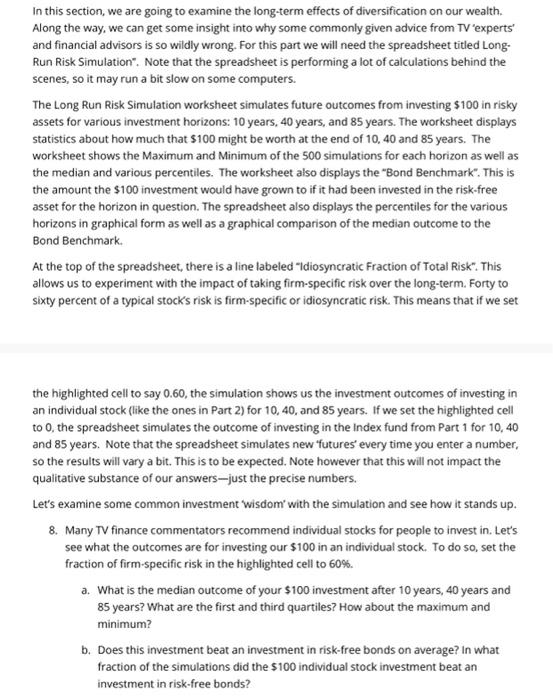In this section, we are going to examine the long-term effects of diversification on our wealth. Along the way, we can get some insight into why some commonly given advice from TV'experts and financial advisors is so wildly wrong. For this part we will need the spreadsheet titled Long- Run Risk Simulation". Note that the spreadsheet is performing a lot of calculations behind the scenes, so it may run a bit slow on some computers. The Long Run Risk Simulation worksheet simulates future outcomes from investing $100 in risky assets for various investment horizons: 10 years, 40 years, and 85 years. The worksheet displays statistics about how much that $100 might be worth at the end of 10.40 and 85 years. The worksheet shows the Maximum and Minimum of the 500 simulations for each horizon as well as the median and various percentiles. The worksheet also displays the "Bond Benchmark". This is the amount the $100 investment would have grown to if it had been invested in the risk-free asset for the horizon in question. The spreadsheet also displays the percentiles for the various horizons in graphical form as well as a graphical comparison of the median outcome to the Bond Benchmark. At the top of the spreadsheet, there is a line labeled "Idiosyncratic Fraction of Total Risk". This allows us to experiment with the impact of taking firm-specific risk over the long-term. Forty to sixty percent of a typical stock's risk is firm-specific or idiosyncratic risk. This means that if we set the highlighted cell to say 0.60, the simulation shows us the investment outcomes of investing in an individual stock (like the ones in Part 2) for 10, 40, and 85 years. If we set the highlighted cell to 0, the spreadsheet simulates the outcome of investing in the Index fund from Part 1 for 10,40 and 85 years. Note that the spreadsheet simulates new futures' every time you enter a number, so the results will vary a bit. This is to be expected. Note however that this will not impact the qualitative substance of our answers-just the precise numbers. Let's examine some common investment wisdom' with the simulation and see how it stands up. 8. Many TV finance commentators recommend individual stocks for people to invest in. Let's see what the outcomes are for investing our $100 in an individual stock. To do so, set the fraction of firm-specific risk in the highlighted cell to 60%. a. What is the median outcome of your $100 investment after 10 years, 40 years and 85 years? What are the first and third quartiles? How about the maximum and minimum? b. Does this investment beat an investment in risk-free bonds on average? In what fraction of the simulations did the $100 individual stock investment beat an investment in risk-free bonds? In this section, we are going to examine the long-term effects of diversification on our wealth. Along the way, we can get some insight into why some commonly given advice from TV'experts and financial advisors is so wildly wrong. For this part we will need the spreadsheet titled Long- Run Risk Simulation". Note that the spreadsheet is performing a lot of calculations behind the scenes, so it may run a bit slow on some computers. The Long Run Risk Simulation worksheet simulates future outcomes from investing $100 in risky assets for various investment horizons: 10 years, 40 years, and 85 years. The worksheet displays statistics about how much that $100 might be worth at the end of 10.40 and 85 years. The worksheet shows the Maximum and Minimum of the 500 simulations for each horizon as well as the median and various percentiles. The worksheet also displays the "Bond Benchmark". This is the amount the $100 investment would have grown to if it had been invested in the risk-free asset for the horizon in question. The spreadsheet also displays the percentiles for the various horizons in graphical form as well as a graphical comparison of the median outcome to the Bond Benchmark. At the top of the spreadsheet, there is a line labeled "Idiosyncratic Fraction of Total Risk". This allows us to experiment with the impact of taking firm-specific risk over the long-term. Forty to sixty percent of a typical stock's risk is firm-specific or idiosyncratic risk. This means that if we set the highlighted cell to say 0.60, the simulation shows us the investment outcomes of investing in an individual stock (like the ones in Part 2) for 10, 40, and 85 years. If we set the highlighted cell to 0, the spreadsheet simulates the outcome of investing in the Index fund from Part 1 for 10,40 and 85 years. Note that the spreadsheet simulates new futures' every time you enter a number, so the results will vary a bit. This is to be expected. Note however that this will not impact the qualitative substance of our answers-just the precise numbers. Let's examine some common investment wisdom' with the simulation and see how it stands up. 8. Many TV finance commentators recommend individual stocks for people to invest in. Let's see what the outcomes are for investing our $100 in an individual stock. To do so, set the fraction of firm-specific risk in the highlighted cell to 60%. a. What is the median outcome of your $100 investment after 10 years, 40 years and 85 years? What are the first and third quartiles? How about the maximum and minimum? b. Does this investment beat an investment in risk-free bonds on average? In what fraction of the simulations did the $100 individual stock investment beat an investment in risk-free bonds







